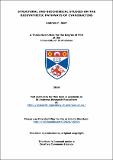Files in this item
Structural and biochemical studies on the biosynthetic pathways of cyanobactins
Item metadata
| dc.contributor.advisor | Naismith, Jim | |
| dc.contributor.author | Bent, Andrew F. | |
| dc.coverage.spatial | xxv, 236 p. | en_US |
| dc.date.accessioned | 2017-03-06T11:26:53Z | |
| dc.date.available | 2017-03-06T11:26:53Z | |
| dc.date.issued | 2016-06-22 | |
| dc.identifier | uk.bl.ethos.707258 | |
| dc.identifier.uri | https://hdl.handle.net/10023/10404 | |
| dc.description.abstract | Cyclic peptides have potential as scaffolds for novel pharmaceuticals, however their chemical synthesis can be challenging and as such natural sources are often explored. Several species of cyanobacteria produce a family of cyclic peptides, the cyanobactins, through the ribosomal synthesis of precursor peptides and post-translational tailoring. The patellamides, a member of the cyanobactin family, are cyclic octapeptides containing D-stereo centres and heterocyclised amino acids. A single gene cluster, patA - patG, contains the genes for the expression of the precursor peptide and the enzymes responsible for post-translational modifications including a heterocyclase, protease, macrocyclase and oxidase. Biochemical and structural analysis on the patellamide and related cyanobactin pathways has been carried out. The crystal structure of PatF, a proposed prenyl transferase, has been determined, highlighting that it is likely evolutionary inactive due to changes to key residues when compared to active homologues. This is in agreement with the knowledge that no naturally prenylated patellamides have been discovered to date. The crystal structure of the macrocyclase domain of PatG has been determined in complex with a substrate analogue peptide. The structure, together with biochemical analysis has allowed a mechanism of macrocyclisation to be proposed, confirming the requirement of a specific substrate conformation to enable macrocyclisation. Using isolated enzymes from the patellamide and related pathways, a small scale library of macrocycles made up of diverse sequences has been created in vitro and characterised by mass spectrometry and in certain cases NMR. In order to further enhance diversity, macrocycles containing unnatural amino acids have been created using three approaches; SeCys derived precursor peptides, intein-mediated peptide ligation and pEVOL amber codon technology. Finally, two oxidase enzymes from cyanobactin pathways have been purified, characterised and confirmed active for thiazoline oxidation. Native X-ray datasets on crystals of the oxidase CyaGox have been collected and phasing trials are on-going. | en_US |
| dc.language.iso | en | en_US |
| dc.publisher | University of St Andrews | |
| dc.rights | Creative Commons Attribution-NonCommercial-NoDerivatives 4.0 International | |
| dc.rights.uri | http://creativecommons.org/licenses/by-nc-nd/4.0/ | |
| dc.subject | Cyanobactins | en_US |
| dc.subject | Cyclic peptides | en_US |
| dc.subject | X-ray crystallography | en_US |
| dc.subject.lcc | QP552.P4B4 | |
| dc.subject.lcsh | Cyclic peptides | en |
| dc.subject.lcsh | Cyclic peptides--Synthesis | en |
| dc.subject.lcsh | Cyanobacteria | en |
| dc.subject.lcsh | X-ray crystallography | en |
| dc.title | Structural and biochemical studies on the biosynthetic pathways of cyanobactins | en_US |
| dc.type | Thesis | en_US |
| dc.contributor.sponsor | Biotechnology and Biological Sciences Research Council (BBSRC) | en_US |
| dc.type.qualificationlevel | Doctoral | en_US |
| dc.type.qualificationname | PhD Doctor of Philosophy | en_US |
| dc.publisher.institution | The University of St Andrews | en_US |
This item appears in the following Collection(s)
Except where otherwise noted within the work, this item's licence for re-use is described as Creative Commons Attribution-NonCommercial-NoDerivatives 4.0 International
Items in the St Andrews Research Repository are protected by copyright, with all rights reserved, unless otherwise indicated.


